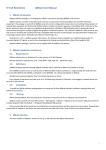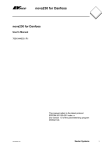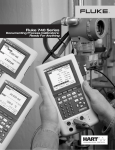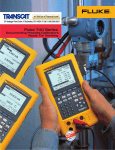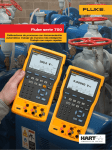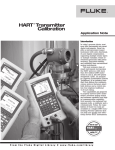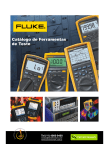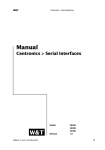Download Operating Instructions Universal measuring unit for heavy current
Transcript
Operating Instructions Universal measuring unit for heavy current variables SINEAX CAM CAM Be Camille Bauer Ltd. Aargauerstrasse 7 CH-5610 Wohlen/Switzerland Phone +41 56 618 21 11 Fax +41 56 618 35 35 [email protected] www.camillebauer.com 156 481-12 09.10 Operating Instructions Universal measuring unit for heavy current variables SINEAX CAM Obligatory safety instructions are marked with the following symbols in these directions: 2. Scope of supply SINEAX CAM (1) 1 Safety instructions (2) 1 Software and documentation CD (3) 1 USB cable (4) 1 2 Device may only be disposed of in a professional manner! Contents 1. Read first and then... ....................................................2 2. Scope of supply ...........................................................2 3. Brief description ...........................................................2 4. Physical installation ......................................................2 4.1 Mounting ................................................................2 4.2 Releasing ................................................................3 5. Electrical connections ..................................................3 5.1 Inputs and outputs .................................................3 5.2 Interface .................................................................5 6. Commissioning.............................................................6 6.1 Software installation ...............................................7 6.2 Parametrization ......................................................7 6.3 Simulation / measurement acquisition ...................7 6.4 Protecting devices ..................................................7 6.5 MODBUS ................................................................7 6.6 Graphic display (optional).......................................7 6.7 Modbus/TCP ..........................................................8 6.8 IEC 61850 ...............................................................8 7. Technical data ..............................................................8 7.1 Measurement input ................................................8 7.2 I/O-Interface .........................................................10 7.3 Interface ...............................................................10 7.4 Further information ...............................................10 7.5 Logger and lists (optional) ....................................11 8. Maintenance ...............................................................12 9. Dimensional drawings ................................................12 10. Safety notes ...............................................................12 11. Declaration of conformity ...........................................12 1. Read first and then … Perfect and safe operation requires that Operating Instructions has been read and understood! This device should only be handled by staff members who are familiar with it and authorised to work on electric facilities. The device must be closed down if safe operation is not possible any more (e.g. visible damage). All connections are to be switched off. The device must be returned to our plant or to a service centre authorised by us. An intervention in the device cancels any warranty claim! 2 4 3 3. Brief description SINEAX CAM is designed for measurements in electric distribution systems or in industrial facilities. Along with the current system state the pollution due to non-linear loads as well as the overall load of the supply system can be detected. Consistent measurement also guarantees that every network change is reliably acquired and included in measured date. The high-performance measuring system makes the device also suitable for strong distorted systems as well as for zero crossing or phase-angle controls. The I/O interface may be individually assorted depending on the application. Up to 4 modules with different functionality may be used. The logger allows long-term recordings of measurement progressions, e.g. to monitor the variable load of transformers, as well as meter readings at definable times. Lists offer the chronological recording of events, alarms or system messages for further analysis of occurrences in the power system. The graphic display is intended for on-site visualization of measurements, lists and alarms. Via keypad the user can e.g. acknowledge alarms or reset extreme values. 4. Physical installation 4.1 Mounting The device is mounted on a top-hat rail. Please ensure tha the operating temperature limits are not exceeded when determining the place of mounting (place of measurement): – 10 … 55 °C Snap housing on the top-hat rail (EN 50 022) (see Fig. 1). Digital outputs 12/24 V DC + x = 4..7 x1 x2 x3 x4 i = 1..4 C1 C2 C3 + I/O i: Digital I/O Rel. – 24 V IN Fig. 1. Mounting on top-hat rail 35 x 15 or 35 x 7.5 mm. 22 kΩ Counter 1) COM 1) Recommended if input resistance > 100 kΩ 4.2 Releasing HV-Input 110/230 VAC Digital inputs 12/24 V DC 24 VDC + – Remove the housing from the mounting rail according to Figure 2. 110-230 VAC ~ x = 4..7 x1 x2 x3 x4 C3 +out -inp Digital I/O C1 C2 I/O i: i = 1..4 Fig. 2 71 72 73 74 ~ I/O 4: ~ 110/230 V Digital inputs 125 V DC 5. Electrical connections 125 VDC + – Screw connections are used. They are designed for cross sections of 4 mm2 for single wire leads and 2 x 2.5 mm2 for multiwire leads. Ensure under all circumstances that the leads are free of potential when connecting them! 71 72 73 74 Please observe, … … that the data on the type plate must be adhered to! I/O 4: Modbus +A –B GND +out -inp Digital I/O C3 Subbus V+ +A –B GND USB 2 1 3 1 2 3 I/O 1 I/O 2 I/O 3 I/O 4 4 41 42 43 44 51 52 53 54 61 62 63 64 71 72 73 74 Re USB Link A marked and easily accessible switch for turning off the power supply has to be arranged in the vicinity of the device. In case of a supply of direct current > 125 V DC, an external fuse has to be provided in the power supply circuit. Otherwise, the national provisions (e.g. in Germany VDE 0100 “Conditions concerning the erection of heavy current facilities with rated voltages below 1000 V”) have to be observed in the installation and material selection of electric lines! C1 C2 5.1 Inputs and outputs Analog outputs Analog inputs + Rext x = 4..7 Rext x1 x2 x3 x4 I - + I - 21 22 23 31 32 33 1 3 4 6 7 9 10 12 2 5 8 11 Rel 1 Rel 2 k l k l k l k l U1 U2 U3 N I1 x = 4..7 C1+ C1- C2+ C2I/O i: 0-20 mA i = 1..4 I3 IN Power supply x1 x2 x3 x4 Rel 1 i = 1..4 I2 13 14 C1+ C1- C2+ C2I/O i: 0-20 mA 21 22 Rel 2 23 31 32 33 When the device is switched off, the status of the relay contact is not defined. Dangerous voltages may occur. 3 Connection modes All voltage measurement inputs must originate at circuit breakers or fuses rated 10 Amps or less. This does not apply to the neutral connector. You have to provide a method for manually removing power from the device, such as a clearly labeled circuit breaker or a fused disconnect switch. When using voltage transformers you have to ensure that their secondary connections never will be short-circuited. No fuse may be connected upstream of the current measurement inputs! When using current transformers their secondary connectors must be short-circuited during installation and before removing the device. Never open the secondary circuit under load. Network / application Terminal arrangement 2 11 1 2 11 1 3 k Four-wire three-phase system balanced load I: L1 L1 N L1 N 2 11 1 u L v U L1 L2 L3 N K l 3 V k l K L Current transf. L2 L3 Terminals 2 11 1 1 L2 L3 N N 3 3 2 5 8 1 3 4 6 7 9 2 5 8 1 3 4 6 7 9 L1 L2 L3 K l L k 2 11 1 u k V l K 2 Three-wire three-phase system asymmetrical load 3 v U L1 N L 2 3 8 1 5 5 3 8 1 k L1 L2 L3 L1 L2 L3 2 8 5 u v u v U V U V k L1 L2 L3 K l K Current transf. L2 L3 l L Terminals 2 5 8 1 1 L2 L3 L3 L1 L1 L2 3 3 K l l L k K l L K 2 1 8 5 u u 4 3 6 L 7 9 u x x x X X X U U U k K l k l L k K l L K L 3 single-pole isolated voltage transformers in the high-voltage system L 3 1 L1 L2 L3 L1 L2 L3 Connect voltage according to the following table in case of current measurement via L2 or L3: 4 L1 L2 L3 N Connect voltage according to the following table in case of current measurement via L2 or L3: 3 k Three-wire three-phase system balanced load I: L1 3 Terminal assignment 2 11 1 Singlephase AC mains 2 11 1 L1 L2 L3 N The connection of the inputs depends on the configured system (connection type). The required device external fusing of the voltage inputs is not shown in the following connection diagrams. Network/ application 3 Network / application 2 Three-wire three-phase system asymmetrical load Aron measuring circuit Network / application Terminal arrangement 8 5 3 1 9 7 2 8 5 3 1 k L1 L2 L3 L1 L2 L3 2 L1 L2 L3 8 5 1 u v u v U V U V k K 3 k L1 L2 L3 l L 8 11 1 5 2 l L 4 3 6 9 7 8 5 1 u u u x x x X X X U U U k K k 8 11 1 3 4 6 7 9 10 12 3 2 8 11 1 3 4 6 7 9 10 12 L1 L2 L3 N l L 7 9 Four-wire three-phase system asymmetrical load Open Y circuit l k L l K L 9 10 12 7 2 l L K 9 7 K 2 K Terminal arrangement k L1 L2 L3 N k l L k K l L K xx 3 2 k XX 8 11 1 5 L1 L2 L3 N 4 3 k K l 6 7 k 9 10 12 4 5 7 6 L 8 9 10 11 12 k l 8 11 1 5 u u x x X X X U U U 4 3 k k K l k 6 7 k K k l l K L L K L K L K L l L 5 1 3 4 6 2 5 1 3 4 6 10 12 11 k l L K L1 L2 N Split phase (”Two-phase network”) asymmetrical load l L K 2 9 10 12 l L k l L K x k l UU 2 single-pole isolated voltage transformers in the high-voltage system L K u L1 L2 L3 N l L K 2 L1 L2 L3 N l uu 2 Four-wire three-phase system asymmetrical load k L K 1 L1 L2 L3 N l K L k 3 single-pole isolated voltage transformers in the high-voltage system U1 U2 U3 N I1 I2 2 5 8 11 1 3 L1 L2 N I3 COM 4 6 + 3V - IN COM 7 10 9 K l k l L k K 11 l L K L 12 L1 L2 L3 N Example with ACP FLEX 300x_5 current sensors 30/300/3000A, which need a 3V power supply 5 5.2 Interface RS485 bus connection (Modbus) The terminals (1, 2, 3) are galvanically isolated from the CAM. The signal wires (1, 2) must be twisted. The GND (3) can be connected with a wire or the cable screen. Screened cables must be used in an environment with interference. The supply resistors (Rs) must be in the bus master interface. simple RS converters do not have these resistors. Devices that have resistors are e.g. W&T13601 (PC print), and W&T86201 converter from Wiesemann & Theis GmbH). Avoid drop cables. A straight network is ideal. A maximum of 32 devices can be connected. The bus configuration is made using the CB-Manager software. MASTER 1) + 3.3/+5V Rx/Tx+,A Rs Rx/Tx-,B GND Rs RS485 Bus Rt Rt +A -B 1 2 -GND +A -B 1 2 3 CAM -GND 3 +A -B -GND +A -B -GND 1 3 1 3 2 2 CAM CAM CAM 1 2 31 3 1) One ground connection only. This is possibly already made at the master (PC). Rt Termination resistors: 120 Ω each for long cables (> approx. 10 m) Rs Bus supply resistors: 500 … 1000 Ω each 6. Commissioning Prior to starting, check that the connection data of the transducer agrees with the system data (see type label). The power supply to the transducer can then be switched on and the signals applied to the measuring inputs. 2 3A 1 4 5 6 4 5 6 Type label of device with conventional current inputs 2 3B 1 Type label of device with Rogowski current inputs (example with 3V supply for Rogowski coil integrator) 6 Symbol Meaning Pos. Meaning Device may only be disposed of in a professional manner! 1 Works No., Manufacturing date Double insulation, device of protection class 2 2 Terminal connections relay outputs CE conformity mark. The device fulfills the requirements of the applicable EC directives. 3A Terminal connections current inputs Caution! General hazard point. Read the operating instructions. 3B Terminal connections when using Rogowski coils General symbol: Input 4 Terminal connections voltage inputs General symbol: Output 5 Input frequency range General symbol: Power supply 6 Terminal connections power supply 6.1 Software installation For the parametrization of the device the supplied PC software CB-Manager has to be installed. To do so, execute the file setup.exe in the CB-Manager directory on the CD. The file “Read Me First.pdf” on the software CD contains all information about the installation of the CB-Manager software as well as assistance for problems concerning USB support. 6.2 Parametrization The usage of the softwarer is comprehensively described under Help | Contents. There you will find also all detail information, which may also be requested context specific. Hereinafter an overview about existing help topics is shown. known from the control panel of Windows. In each register you may request context specific help. Therefore this manual will only describe some functions using elements from more than one register. Sequence When entering the device configuration you have to consider a useful sequence. After defining the device hardware in the register device you have to enter the input parameters, because all the following inputs will depend on these settings. A help to do this is the function “Next”, which navigates you through the registers in a predefined sequence, depending on the selected hardware. This function minimizes possible dependencies. State signalling to digital or relay outputs Only via logic module it is possible to output a determined logic state to a digital or relay output. Logic states may be determined from limit value states, states of digital inputs, values received via bus interface or previous calculated logic states. But all these possible logic inputs have to be defined in advance: Limit values in the register limit value and digital inputs in the register I/Ox, which must have the functionality digital input. Further information may be obtained from the help of the logic module. Meters The device configuration may be performed ONLINE (with existing connection to the device) or OFFLINE (without connection to the device). Select Parameter | Edit in the device menu to see an overview of the present settings. You always will be asked if the present parametrization should be read from the device. The complete configuration of the device is devided in subjects and displayed in a register form. This type of display is well Analog or digital inputs may be used to build meters. The definition of the measurands to summarize is done via the I/O registers of the appropriate I/O modules. The register meters will then display all possible meters and provides the possibility to activate the tariff switching to build high and low tariff meters. This meters list does not contain the 12 active and reactive power meters of the standard fitting. 6.3 Simulation / Measurement acquisition The behaviour of the I/O modules may be simulated during commissioning. By setting states or measurement values it is possible to test if following circuits show the correct behaviour resp. if the SINEAX CAM responds to input devices the right way. 7 All measurement values may be read via USB or RS485 interface and displayed using the CB-Manager software. Use the device menu “visualisation” and the desired measurement type to go to the appropriate measurement representation and start the acquisition. The data will be displayed and logged. The logged data may be stored on disk for future analysis. 7. Technical data The complete technical data is given in the data sheet of the device. 7.1 Measurement input (Terminals 1-12) Frequency range: 45…50/60…65 Hz or 10…50/60…70 Hz or 10…50/60…140 Hz Measurement TRMS: up to the 63rd harmonic 6.4 Protecting devices For each device user rights can be configured. The right to change configuration data or to set/reset extreme values, meters or slave pointers may be committed this way selectively for up to 3 different users. To perform appropriate functions it is then necessary to enter usename and password in advance. Measurement category: ≤ 300 V CATIII, ≤ 600 V CATII Current measurement Rated current: 1 A (+ 20%), 1 A (+ 100%), 5 A (+ 20%), 5 A (+ 100%) To be able to define user rights the input of an administrator login is required. The factory setting is: Overriding max.: 10 A (sinusoidal) Consumption: ≤ I2 x 0.01Ω per phase User: admin Password: admin Thermal ratings: 12 A continuous 100 A, 10 x 1 s, Interval 100 s ATTENTION: To reset forgotten passwords it’s necessary to send the device back to the factory! Instead of current inputs the version for Rogowski coils provides voltage inputs of nominal 5 V (max. 10 V). 6.5 MODBUS For customer specific MODBUS solutions the protocol and all necessary information is summarized in the document “SINEAX CAM Modbus interface”. This may be found on the CD as well. Voltage measurement Rated voltage: 600 VLN, 1040 VLL (sinusoidal) Consumption: ≤ U2 / 3 MΩ per phase Input impedance: 3 MΩ per phase Thermal ratings: 480 VLN, 832 VLL continuous 600 VLN, 1040 VLL, 10 x 10 s, Interval 10 s 800 VLN, 1386 VLL, 10 x 1 s, Interval 10 s 6.6 Graphic display (optional) The parametrization of the graphic display and the assembling of user specific measurement displays is performed using the CB-Manager software. Parameters like contrast or the selection of the display language (English, German, French, Czech, Spanish, Dutch, Italian) can be set also directly using the keypad. The operation of the graphic display is described in a separate document, which is attached in English and German to all devices equipped with display. The appropriate manuals for all languages may be found on the provided software CD. 6.7 Rogowski current inputs (optional) This version provides instead of current inputs voltage inputs for connecting the integrator circuit of Rogowski coils. These can be fitted quickly and easily without opening the current circuit and can cover a wide current range. Rogowski coils can respond to fast-changing currents and transmit harmonics much better than conventional current transformers. Thus this version is suited for applications where an accurate analysis of harmonics resp. system feedback is required, as well as for test facilities, where the device under test must be replaced often and quickly. The power supply of the Rogowski coil integrator can be performed via CAM directly. 6.8 Modbus/TCP The Ethernet communication by means of the Modbus/TCP protocol is described in the separated document “Modbus/ TCP interface SINEAX CAM” (see documentation CD). 6.9 IEC 61850 The IEC 61850 communication is documented separately. See documentation on the CD or on our homepage http://www.camillebauer.com 8 57.7 … 400 VLN, 100 … 693 VLL Overriding max.: System Single-phase Split Phase 3-wire system, balanced load 3-wire system, unbalanced load 3-wire system, unbalanced load (Aron) 4-wire system, balanced load 4-wire system, unbalanced load 4-wire system, unbalanced load (Open-Y) 1L 2L 3Lb 3Lu 3Lu.A 4Lb 4Lu 4Lu.O Basic accuracy under reference conditions acc. IEC/EN 60 688, sinusoidal 50-60 Hz, 15 to 30 °C Voltage: Current: Power: Power factor: Frequency: Voltage unbalance: Harmonics: THD Voltage: TDD Current: Energy: Active energy direct connection: Active energy transformer connection: Reactive energy: ± 0.1% FS a) ± 0.1% FS a) ± 0.2% FS b) ± 0.1° ± 0.01 Hz ± 0.2% ± 0.5% ± 0.5% ± 0.5% ± 0.2% FS b) Kl. 1 / EN 62 053-21 Kl. 2 / EN 62 053-21 Kl. 2 / EN 62 053-23 Influence quantities and permissible variations Basic measurement quantities a) : FS: Maximum value of the input configuration (Full Scale) b) : FS: FS-Voltage x FS-Current Measured quantity present max 1L 2L 3Lb 3Lu 3Lu.A 4Lb 4Lu 4Lu.O System analysis quantities Measured quantity Voltage unbalance unb. U THD Voltage THD.U1N THD Voltage THD.U2N THD Voltage THD.U3N THD Voltage THD.U12 THD Voltage THD.U23 THD Voltage THD.U31 TDD Current TDD.I1 TDD Current TDD.I2 TDD Current TDD.I3 Harmonics H2-50.U1 Harmonics H2-50.U2 Harmonics H2-50.U3 Harmonics H2-50.U12 Harmonics H2-50.U23 Harmonics H2-50.U31 Harmonics H2-50.I1 Harmonics H2-50.I2 Harmonics H2-50.I3 • • • • • • • • • • • • • • • • • • • • • • • • • • • • • • • • • • • • • • ✓ ✓ ✓ ✓ ✓ ✓ ✓ ✓ ✓ ✓ ✓ ✓ ✓ ✓ ✓ ✓ ✓ ✓ ✓ ✓ ✓ ✓ ✓ ✓ ✓ ✓ ✓ ✓ ✓ ✓ ✓ ✓ ✓ ✓ ✓ ✓ ✓ ✓ ✓ ✓ ✓ ✓ ✓ ✓ ✓ ✓ ✓ ✓ ✓ ✓ ✓ ✓ ✓ ✓ ✓ ✓ ✓ ✓ ✓ ✓ ✓ ✓ ✓ ✓ ✓ ✓ ✓ ✓ ✓ ✓ ✓ ✓ ✓ ✓ THD U (Total Harmonic Distortion): Harmonic content related to the fundamental of the RMS value of voltage. TDD I (Total Demand Distortion): Harmonic content related to the fundamental of the RMS value of the rated current. Energy meters (High and low tariff) Active energy: Incoming Active energy: Outgoing Reactive energy: Incoming Reactive energy: Outgoing Reactive energy: inductive Reactive energy: capacitive Relationship between PF, QF and LF Output ind. ind. cap. cap. QF PF –180 –90 0 90 180 LF ϕ Voltage U Voltage U1N Voltage U2N Voltage U3N Voltage U12 Voltage U23 Voltage U31 Voltage UNE Current I Current I1 Current I2 Current I3 I-Bimetal 1-60 min IB I1-Bimetal 1-60 min IB1 I2-Bimetal 1-60 min IB2 I3-Bimetal 1-60 min IB3 Neutral current IN Active power Σ P Active power P1 Active power P2 Active power P3 Reactive power Σ Q Reactive power Q1 Reactive power Q2 Reactive power Q3 Apparent power Σ S Apparent power S1 Apparent power S2 Apparent power S3 Frequency F Active power factor Σ PF Active power factor PF1 Active power factor PF2 Active power factor PF3 PF Σ Incoming ind. PF Σ Incoming cap. PF Σ Outgoing ind. PF Σ Outgoing cap. React. power factor Σ QF React. power factor QF1 React. power factor QF2 React. power factor QF3 LF power factor Σ LF LF power factor LF1 LF power factor LF2 LF power factor LF3 (U1N+U2N) / 2 Um (U1N+U2N+U3N) / 3 Um (U12+U23+U31) / 3 Um (I1+I2) / 2 Im (I1+I2+I3) / 3 Im present max min 1L 2L 3Lb 3Lu 3Lu.A 4Lb 4Lu 4Lu.O According to IEC / EN 60 688 • • • • • • • • • • • • • • • • • • • • • • • • • • • • • • • • • • • • • • • • • • • • • • • • • • • • • • • • • • • • • • • • • • • • • • • • • • • • • • • • • • • • ✓ ✓ ✓ ✓ ✓ ✓ ✓ ✓ ✓ ✓ ✓ ✓ ✓ ✓ ✓ ✓ ✓ ✓ ✓ ✓ ✓ ✓ ✓ ✓ ✓ ✓ ✓ ✓ ✓ ✓ ✓ ✓ ✓ ✓ ✓ ✓ ✓ ✓ ✓ ✓ ✓ ✓ ✓ ✓ ✓ ✓ ✓ ✓ ✓ ✓ ✓ ✓ ✓ ✓ ✓ ✓ ✓ ✓ ✓ ✓ ✓ ✓ ✓ ✓ ✓ ✓ ✓ ✓ ✓ ✓ ✓ ✓ ✓ ✓ • ✓ ✓ ✓ ✓ ✓ ✓ ✓ ✓ ✓ ✓ ✓ ✓ ✓ ✓ • • • • ✓ ✓ ✓ ✓ ✓ ✓ ✓ ✓ ✓ ✓ ✓ ✓ ✓ ✓ ✓ ✓ ✓ ✓ ✓ ✓ ✓ ✓ ✓ ✓ ✓ ✓ ✓ ✓ ✓ ✓ ✓ ✓ ✓ ✓ ✓ ✓ ✓ ✓ ✓ ✓ ✓ ✓ ✓ ✓ ✓ ✓ ✓ ✓ ✓ ✓ ✓ ✓ ✓ ✓ ✓ ✓ ✓ ✓ ✓ ✓ ✓ ✓ ✓ ✓ ✓ ✓ ✓ ✓ ✓ ✓ ✓ ✓ ✓ ✓ ✓ ✓ ✓ ✓ ✓ ✓ ✓ ✓ ✓ ✓ ✓ ✓ ✓ ✓ ✓ ✓ ✓ ✓ ✓ ✓ ✓ ✓ ✓ ✓ ✓ ✓ ✓ ✓ ✓ ✓ ✓ ✓ ✓ ✓ ✓ ✓ ✓ ✓ ✓ ✓ ✓ ✓ ✓ ✓ ✓ ✓ ✓ ✓ ✓ Measurement calculation acc. DIN 40 110 incl. 4-quadrant measurement. outgoing incoming outgoing Fig. 3. Active power factor PF ––––, reactive power factor QF ------, power factor LF – - – - –. 9 7.2 I/O-Interface Input current Relay (Terminals 21-23, 31-33) Counting frequency (S0) ≤ 50 Hz Number: 2 Logical ZERO – 6 till + 20 V Contacts: Changeover contact Logical ONE 30 till 157 V Load capacity: 250 V AC, 2 A, 500 VA 30 V DC, 2 A, 60 W Switching limit Approx. 25 V / 0.8 mA I/O-Module (optional, Terminals 41-74) Up to 4 different groups of terminals (41-44, 51-54, 61-64, 71-74) with defined input/output functions are available depending on the selected options. These groups are galvanically isolated from each other and from the rest of the device. The following modules are available: < 2.5 mA HV-Input 110/230 V AC (for terminals 71, 74 only) 1 input for RTC synchronization or state recognition Function: Rated voltage: Synchronization RTC, Logic 110 till 230 V AC (≥ 100 V AC, ≤ 264 V AC) Frequency range: 45 till 65 Hz Logical ZERO: 0 till 40 V AC Logical ONE: 80 till 264 V AC Analog outputs 2 active current outputs per group of terminals Switching limit: Approx. 60 V AC / 1.9 mA ± 20% Linearization: linear, quadratic, kinked 7.3 Interface Range: 0/4-20 mA (24 mA max.), unipolar or ± 20 mA (24 mA max.), bipolar Modbus connection (plug-in screw terminals 1, 2, 3) Function: Configuration, Measurement acquisition Accuracy: ± 0.1% of 20 mA Protocol: Modbus RTU Burden: ≤ 500 Ω (max. 10 V / 20 mA) Physics: Galvanical isolation: From all other connections (connected within group of terminals) RS-485, max. distance 1200 m (4000 ft) Baudrate: Configurable (1.2 till 115.2 kBaud) Analog inputs 2 current inputs per group of terminals Number of bus stations: ≤ 32 Range: 0/4–20 mA (24 mA max.), unipolar USB connection (USB Mini-B, 5 contacts) Accuracy: ± 0.1% of 20 mA Function: Galvanical isolation: From all other connections (connected within group of terminals) Configuration, Measurement acquisition Protocol: USB 2.0 Digital inputs/outputs 3 per group of terminals, in relation to software configurable as passive inputs or outputs (all the same), acc. EN 61 131-2 Subbus connection (plug-in screw terminals 1, 2, 3, 4) Inputs (acc. EN 61 131-2 DC 24 V Type 3): Function: Configuration, measurement acquisition Protocol: Modbus/TCP or IEC 61850 (depending on the version ordered) Function: State input, pulse counter Rated voltage: 12/24 V DC (30 V max.) Input current: < 7.0 mA Counting frequency (S0): ≤ 50 Hz Logical ZERO: – 3 till + 5 V Logical ONE: 8 till 30 V Switching limit: approx. 6.5 V /2.6 mA Function: reserved for future device options Ethernet (RJ-45), optional 7.4 Further information Outputs (partly acc. EN 61 131-2): Power supply (Terminals 13, 14) Option 1: AC, 50 - 400 Hz: DC: Consumption: Inrush current: 100 … 230 V ± 15% 100 … 230 V ± 15% ≤ 10 W resp. ≤ 20 VA < 25 A / 0.3 ms Option 2: DC: Consumption: 24 … 60 V ± 15% ≤ 10 W Function: State output, pulse output, self-monitoring Rated voltage: 12/24 V DC (30 V max.) Rated current: 50 mA (60 mA max.) Switching frequency (S0): ≤ 20 Hz Limit module (Software function GW1 till 64) 64 Limit values for monitoring measurement limits Load capacity: 400 Ω … 1 MΩ Limit for ON state: programmable Limit for OFF state: programmable Digital inputs 125 V DC 3 per group of terminals Function State input Rated voltage 48 / 125 V DC (157 V max.) 10 Logic module (Software function LS1 till 32) 32 Logic functions to combine logical states: Limit values, digital inputs, LS-states and default values. Output to digital outputs, relays or other LS functions possible. Response time 40ms + 17ms + 0ms + 30ms = 87ms Internal clock (RTC) Function: Time reference, Counter for operating hours Accuracy: ± 2 Minutes/Month (15 till 30°C) trimmable via PC-Software Operating temperature: – 10 till 15 till 30 till 55 °C Storage temperature: – 25 till + 70 °C Synchronization via: Measurement input, HV-Input 110/230 V AC, Synchronization pulse (digital input) Relative humidity: < 95% no condensation Variations due to ambient temperature: 0.5x Basic accuracy per 10 K > 10 years Long term drift: 0.2x Basic accuracy per year Altitude: ≤ 2000 m max. Others: Usage group II acc. IEC / EN 60 688 Running reserve: Response time The total response time is the addition of the measurement time t1 of the input quantities and the processing time t2 for the respective output (analog output, bus, digital output, relay). Meas. time t1 Processing time t2 t Ambient conditions, general information Mechanical attributes Dimensions: 186 x 90 x 62 mm Mounting: On top-hat rail acc. DIN EN 50 022 (35 x 15 mm and 35 x 7.5 mm) Orientation: Any Input quantities Analog output Modbus, USB Limit Logic Digital monitoring module output Relay Housing material: Polycarbonat (Makrolon) Flammability class: V-0 acc. UL 94, self-extinguishing, non-dripping, free of halogen Weight: 500 g Security Basic measurement quantities The current inputs are galvanically isolated from each other. Measurement interval: programmable, 1 .. 999 periods (Averaging time RMS value) Protection class: II (protective insulation, voltage inputs via protective impedance) Measurement time t1: 2 x measurement interval + 17ms Pollution degree: 2 Enclosure protection: IP 40, housing (test wire, IEC/EN 60 529 IP 20, terminals (test finger, IEC/EN 60 529) Measurement time t1 System analysis quantities Measurement interval: 18 periods Measurement time t1: 2 x measurement interval Analog input Measurement time t1: 25 ms .. 30 s (programmable) Digital input Measurement time t1: < 25 ms HV-Input 110/230 V AC Measurement time t1 Measurement category: CAT III (at ≤ 300 V versus earth) CAT II (at > 300 V versus earth) Rated voltage (versus earth): Power supply: 265 V AC Relay: 250 V AC I/O’s: 30 V DC 264 V AC(HV-Input) 7.5 Logger and lists (optional) 2 till 255 periods (programmable) Total response time t1 + t2 Analog output: t1 + 10 ms .. 60 s, programmable Modbus / USB: t1 Digital output: t1 + 8 ms + Logic module Relay: t1 + 30 ms + Logic module (Logic module: Switch-in/dropout delay 0…65 s, programmable) Example: Relay has to toggle if P > Plimit, rated frequency is 50 Hz, Averaging time is 1 period, switch-in delay logic set to 0 s By means of these options measurements and events may be long-term recorded. Depending on the application 7 different kinds of data may be acquisited: – Progression of mean-values with interval time t1 (1s…60min) – Progression of mean-values with interval time t2 (1s … 60min) – Min/Max values during interval t3 (1s … 3h) – Meter readings – List entries of alarms – List entries of events – List entries of system messages They share the available storage space of 64Mb size. The memory allocation may be performed using the CB-Manager 11 software. Due to the high degree of freedom for the configuration of logger and lists no general information about the maximal storage duration can be given. But these can be seen in the software when selecting the memory allocation, the measurands to store and the number of list entries. The reading and analyzing of logger and list data can be done using the CB-Analyzer software. 8. Maintenance 11. Declaration of conformity EG - KONFORMITÄTSERKLÄRUNG DECLARATION OF CONFORMITY Dokument-Nr./ Document.No.: CAM_CE-konf.DOC Hersteller/ Manufacturer: Camille Bauer AG Switzerland Anschrift / Address: Aargauerstrasse 7 CH-5610 Wohlen Produktbezeichnung/ Product name: U n i ve r s e l l e M e s s e i n h e i t f ü r S t a r k s t r o m g r ö s s e n U n i ve r s a l M e a s u r i n g U n i t f o r h e a vy c u r r e n t va r i a b l e s Typ / Type: SINEAX CAM Das bezeichnete Produkt stimmt mit den Vorschriften folgender Europäischer Richtlinien überein, nachgewiesen durch die Einhaltung folgender Normen: Bevore delivery the device is checked to assure your personal safety. Unauthorized opening of the device invalidates the warranty and the unit must be sent back to the factory for repeating all necessary checks. The calibration of the device and the alteration of the I/O module disposition can be performed in our factory only. We recommend a yearly recalibration of the device to ensure the long-term accuracy. The above mentioned product has been manufactured according to the regulations of the following European directives proven through compliance with the following standards: Nr. / No. R i c h t l i n i e / D i r e c t i ve 2004/108/EG 2004/108/EC Elektromagnetische Verträglichkeit - EMV - Richtlinie Electromagnetic compatibility -EMC directive EMV / EMC Fachgrundnorm / Generic Standard Störaussendung / Emission Störfestigkeit / Immunity EN 61000-6-4 : 2007 EN 55011 : 2007+A2:2007 EN 61000-6-2 : 2005 IEC IEC IEC IEC IEC IEC IEC Nr. / No. R i c h t l i n i e / D i r e c t i ve 2006/95/EG E l e k t r i s c h e B e t r i e b s m i t t e l z u r V e r we n d u n g i n n e r h a l b b e s t i m m t e r S p a n n u n g s grenzen – Niederspannungsrichtlinie – CE-Kennzeichnung : 95 E l e c t r i c a l e q u i p m e n t f o r u s e wi t h i n c e r t a i n v o l t a g e l i m i t s – L o w V o l t a g e D i r e c tive – Attachment of CE mark : 95 2006/95/EC M e s s ve r f a h r e n / Measurement methods 61000-4-2: 1995+A1:1998+A2:2001 61000-4-3: 2006+A1:2007 61000-4-4: 2004 61000-4-5: 2005 61000-4-6: 2008 61000-4-8: 1993+A1:2000 61000-4-11: 2004 EN/Norm/Standard IEC/Norm/Standard EN 61 010-1 : 2001 IEC 1010-1 : 2001 9. Dimensional drawings 2 1 3 1 2 3 4 41 42 43 44 51 52 53 54 61 62 63 64 Ort, Datum / Place, date: 71 72 73 74 Wohlen, 17.Februar.2009 USB Re 98 90 Link Unterschrift / signature: 21 22 23 31 32 33 1 3 4 6 7 9 186 10 12 2 5 8 11 13 14 63 10. Safety notes ● Before you start the device check for which power supply it is built. ● Verify that the connection leads are in good condition and that they are electrically dead while wiring the device. ● When it must be assumed that safe operation is no longer possible, take the device out of service (eventually disconnect the power supply and the input voltage!). This can be assumed on principle when the device shows obvious signs of damage. The device must only be used again after troubleshooting, repair and a final test of calibration and dielectric strength in our factory or by one of our service facilities. ● When opening the cover, live parts may be exposed. Calibration, maintenance or repair with the device open and live must only be performed by a qualified person who understands the danger involved. Capacitors in the device may still be charged even though the device has been disconnected from all voltage sources. 12 M. Ulrich J. Brem Leiter Technik / Head of engineering Qualitätsmanager / Quality manager













